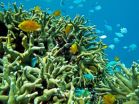(Press-News.org) Researchers have today released ground-breaking findings that dismiss the 'Neutral Theory of Biodiversity'. The theory has dominated biodiversity research for the past decade, and been advocated as a tool for conservation and management efforts.
Professor Sean Connolly from the ARC Centre of Excellence for Coral Reef Studies (Coral CoE) at James Cook University (JCU) is the lead author of the international study, which he says overturns the long-used theory by employing a novel mathematical method. It is the largest study of its kind, covering a broad range of marine ecosystems on Earth.
"The study has important implications for how marine conservation areas are managed," Professor Connolly says.
"The aim of neutral theory is to explain diversity and the relative abundances of species within ecosystems. However, the theory has an important flaw: it fails to capture how important the highly abundant species that dominate marine communities are."
Professor Connolly explains that it's often the really abundant species that deliver substantial ecosystem services like providing habitat for fishes, or keeping reefs clear of seaweeds. "These species have unique features that allow them to be so abundant, and to play those key roles," he says.
But when neutral theory underpins marine conservation, species are treated as swappable. "So the theory implies that, if you lose a really abundant species, then another can simply increase in abundance to take its place."
Using neutral theory, species become common or rare as a consequence of random processes: chance variation in who a predator happens to eat, or whose dispersing offspring happen to land on a vacant bit of real estate on the seafloor. This study shows that these random processes are not strong enough to explain the large differences between common and rare species.
Professor Connolly points to Caribbean coral reefs as an example of why this problem with neutral theory can be important. "Until the 1970s, these reefs were dominated by two species that were close relatives of the branching corals that dominate the reefs of the Great Barrier Reef. When these species were nearly lost as a consequence of overfishing and other forms of reef degradation, no other coral species increased to fill the gap," he says.
"Those species had particular traits that made them so abundant, and therefore critical to a functioning healthy reef system," continues Dr Julian Caley a co-author of the study from the Australian Institute of Marine Studies (AIMS).
"Both biodiversity theory and conservation managers need to be alert to these characteristics, because it is often the common species, not the rare ones, that are most important to healthy ecosystems," Dr Caley explains.
"The results of this study are also unprecedented in their remarkable consistency across a very large set of vastly different ecological systems throughout the world's oceans," he adds.
The study looks at 14 different marine ecosystems sampled at 1185 locations across the globe. The datasets range from the polar to tropical regions, from deep-sea to shallow coral reef environments and intertidal zones. It includes vertebrates as well as invertebrates, from plankton, to clams, to coral reef fishes.
To overturn neutral theory, the study used a novel mathematical method that identified common predictions of the different models that form the theory. These predictions were then tested against this wide array of marine ecosystems.
INFORMATION:
PAPER & IMAGES
'Commonness and rarity in the marine biosphere' by Sean R. Connolly, M. Aaron MacNeil, M. Julian Caley, Nancy Knowlton, Ed Cripps, Mizue Hisano, Loïc Thibaut, Bhaskar D. Bhattacharya, Lisandro Benedetti-Cecchi, Russell E. Brainard, Angelika Brandt, Fabio Bulleri, Kari E. Ellingsen, Stefanie Kaiser, Ingrid Kröncke, Katrin Linse, Elena Maggi, Timothy D. O'Hara, Laetitia Plaisance, Gary C. B. Poore, Santosh K. Sarkar, Kamala K. Satpathy, Ulrike Schückel, Alan Williams, and Robin S. Wilson appears in Proceedings of the National Academy of Sciences.
The full paper is available via: PNASnews@nas.edu
Image credit: Researchers studied a wide range of abundant and rare species. Scott Reef, WA, Australia. Copyright AIMS.
(more images available on request)
CONTACTS:
Professor Sean Connolly, Coral CoE, (07) 4781 4242, sean.connolly@jcu.edu.au
Dr Julian Caley, AIMS, 0439 472 148, j.caley@aims.gov.au
Jenny Lappin, Coral CoE (07) 4781 4222, jennifer.lappin@jcu.edu.au
Melissa Lyne, media liaison, 0415 514 328, melissa.lyne@gmail.com
New biodiversity study throws out controversial scientific theory
2014-05-27
ELSE PRESS RELEASES FROM THIS DATE:
Does apolipoprotein E mimetic peptide reduce neuronal apoptosis induced by DBI?
2014-05-27
Because the majority of patients with diffuse brain injury are not suitable candidates for surgery, neuroprotective agents are of great importance. Apolipoprotein E exerts a neuroprotective effect against brain injury, but synthetic apolipoprotein E cannot cross the blood-brain barrier, thus limiting its application.It has been reported that apolipoprotein E (138) mimetic peptide can cross the blood-brain barrier in both normal and injured brain. However, its impact on neurological function following diffuse brain injury is still unclear. Prof. Jianmin Li and team from ...
A novel disease-preventing antioxidant pathway
2014-05-27
Interested in antioxidants? They protect us against aging and cancer. It's one of the reasons we like our green tea and even our broccoli. But there is a new kid on the antioxidant block - uric acid. But wait, you're thinking, doesn't uric acid cause gout? A team in Singapore has recently showed that uric acid is a major intracellular antioxidant, possibly even more important than the antioxidants we try to eat. They also discovered how uric acid helps to prevent aging and disease and how it helps in the treatment of cancer.
Traditionally, uric acid has a bad reputation ...
Immunologists discover immune system precursor cells that fight infection
2014-05-27
The innate immune system recognizes infectious agents such as viruses and bacteria. A group of lymphocytes known as "innate lymphoid cells" or ILCs plays a central role in the defense of the human body against infective agents. Professor Andreas Diefenbach of the Research Center Immunology at the Mainz University Medical Center, working in collaboration with scientists at the University of Freiburg, has discovered previously unidentified ILCs that are able to protect epithelial surfaces, such as those of the intestinal mucosa, against infection. The results provide important ...
Using thoughts to control airplanes
2014-05-27
The pilot is wearing a white cap with myriad attached cables. His gaze is concentrated on the runway ahead of him. All of a sudden the control stick starts to move, as if by magic. The airplane banks and then approaches straight on towards the runway. The position of the plane is corrected time and again until the landing gear gently touches down. During the entire maneuver the pilot touches neither pedals nor controls.
This is not a scene from a science fiction movie, but rather the rendition of a test at the Institute for Flight System Dynamics of the Technische Universität ...
Melatonin makes old bones stronger
2014-05-27
Faleh Tamimi, a professor in McGill's School of Dentistry, is the leader of a research team that has just discovered that melatonin supplements make bones stronger in elderly rats and therefore, potentially, in elderly humans too. "Old rats are tedious to work with because they get sick a lot and that means they also cost a lot more. But if you're interested in diseases like osteoporosis, they're an essential part of the process."
Dem bones, dem bones, dem dry bones – sleep and bone regulation
The process of bone breakdown and buildup is affected by our circadian ...
Intermediaries increase corruption
2014-05-27
This news release is available in Spanish.
In reality, an intermediary participates in many, if not most, cases of corruption. However there has been very scarce empirical evidence that illuminates their role in these situations. This is what a researcher at UC3M has analyzed in collaboration with scientists from Florida State University and Southern Methodist University, in Texas (both in the United States). The results of their study, recently published in Experimental Economics, confirm their suspicions: "Our work showed that the number of persons involved in cases ...
Outgrowing emotional egocentricity
2014-05-27
This news release is available in German. Children are more egocentric than adults. Scientists from the Max Planck Institute for Human Cognitive and Brain Sciences in Leipzig have demonstrated for the first time that children are also worse at putting themselves in other people's emotional shoes. According to the researchers, the supramarginal gyrus region of the brain must be sufficiently developed in children for them to be able to overcome their egocentric take on the world.
When little Philip rejoices at winning the prize in a game, it is almost impossible for ...
People attribute free will to mind, not soul
2014-05-27
PROVIDENCE, R.I. [Brown University] — Across the board, even if they believed in the concept of a soul, people in a new study ascribed free will based on down-to-Earth criteria: Did the actor in question have the capacity to make an intentional and independent choice? The study suggests that while grand metaphysical views of the universe remain common, they have little to do with how people assess each other's behavior.
"I find it relieving to know that whether you believe in a soul or not, or have a religion or not, or an assumption about how the universe works, that ...
HIV can cut and paste in the human genome
2014-05-27
For the first time researchers have succeeded in altering HIV virus particles so that they can simultaneously, as it were, 'cut and paste' in our genome via biological processes. Developed at the Department of Biomedicine at Aarhus University, the technology makes it possible to repair genomes in a new way. It also offers good perspectives for individual treatment of both hereditary diseases and certain viral infections:
"Now we can simultaneously cut out the part of the genome that is broken in sick cells, and patch the gap that arises in the genetic information which ...
'Virtual human' shows that stiff arteries can explain the cause of high blood pressure
2014-05-27
High blood pressure is highly age-related and affects more than 1 billion people worldwide. But doctors can't fully explain the cause of 90 per cent of all cases. A computer model of a "virtual human" suggests that stiff arteries alone are enough to cause high blood pressure.
"Our results suggest that arterial stiffness represents a major therapeutic target. This is contrary to existing models, which typically explain high blood pressure in terms of defective kidney function," says Klas Pettersen, a researcher at the Norwegian University of Life Sciences and first author ...



